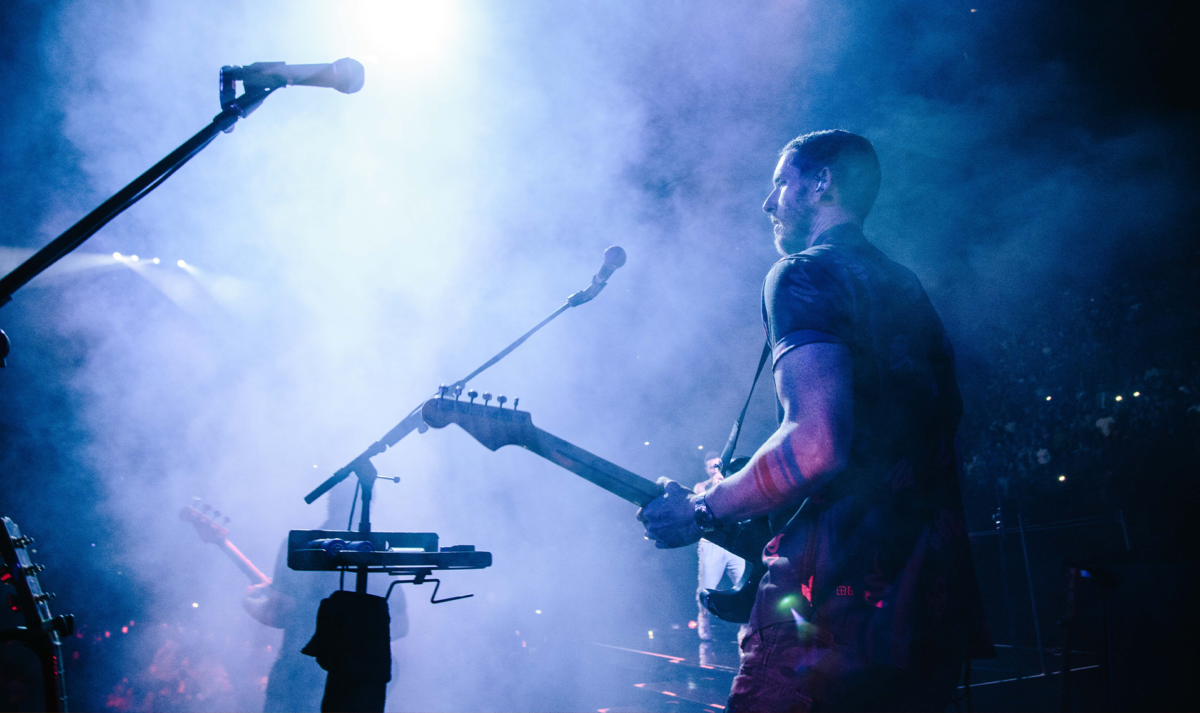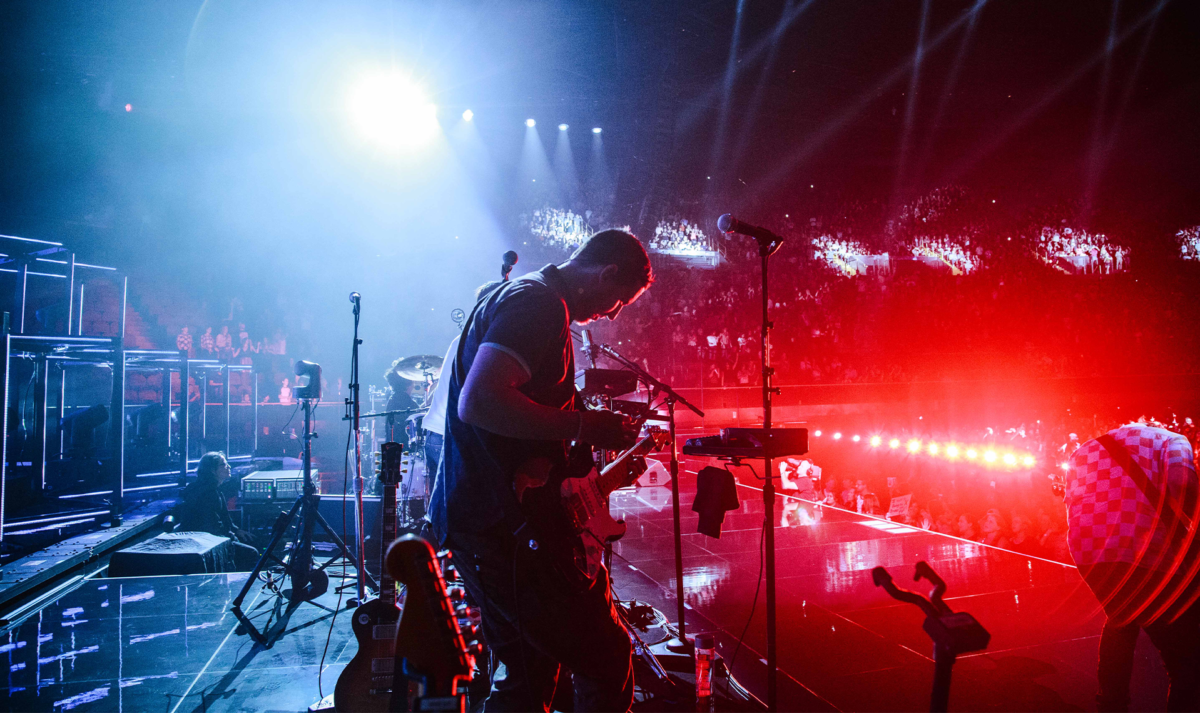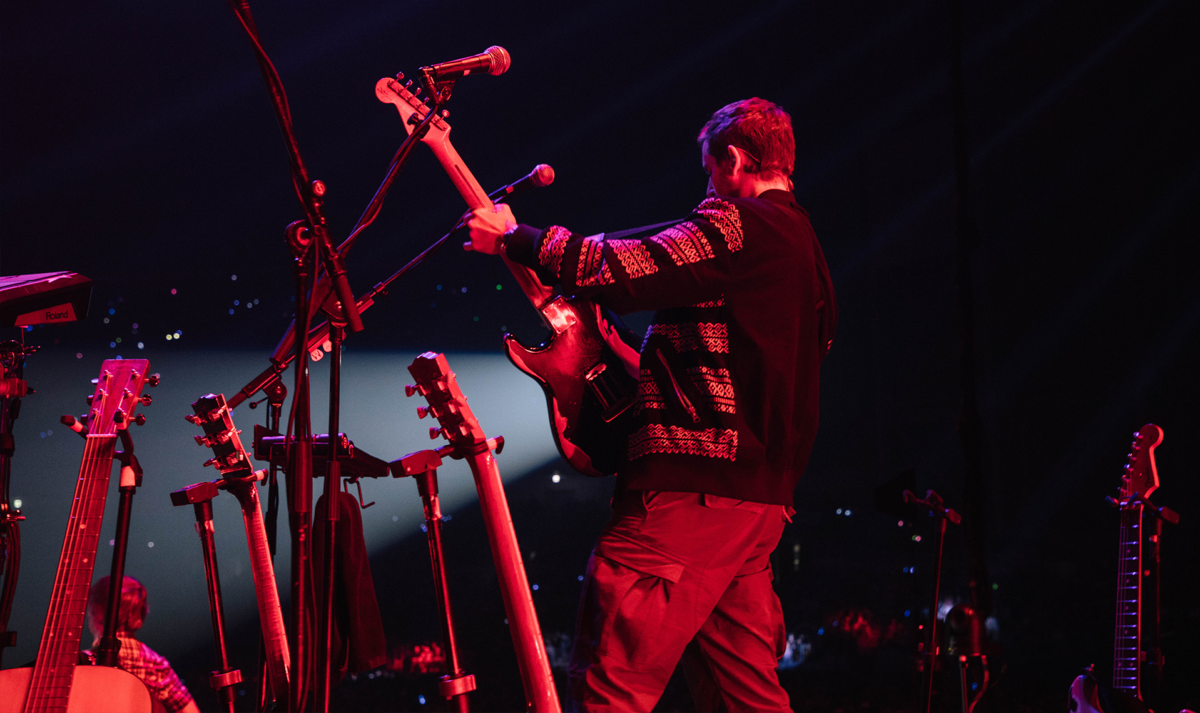Guitarist Jesse Carmichael has been playing music with his Maroon 5 bandmates since he was a teenager. 27 years later, the Grammy-winning rockers are one of the biggest bands in the world, having sold over 120 million records and headlined the Super Bowl halftime show with Big Boi and Travis Scott.
But despite their fabled origins and astronomical success, Maroon 5’s journey to stardom has been a wild one, fraught with unpredictability, evolution, and – as Jesse explains – really hard work. Their headlining “M5 On The Road Tour” lasted a jaw-dropping three years and spanned 132 concerts across the globe – just one example of the grueling pace that resulted in Jesse taking a two-year sabbatical from the band to pursue healing and interpersonal growth. The crucial leave of absence gave him room to evolve as a person and a musician, and brought him back to the band with renewed passion and perspective.
In a career spanning three decades, Maroon 5 has consistently embraced transformation – and this theme of ongoing evolution is something that really shines through in Jesse’s presets: “This idea of randomness is something that I really like to embrace. There’s an element of chance involved,” he says. But what does it take to keep a pop rock juggernaut running at full tilt? We sat down with Jesse to discuss his musical origins, the necessity of personal and artistic growth, and the stories behind all five of his elegantly unpredictable GUITAR RIG 6 presets. Read on to the end to check out exclusive video demos of each signature sound.

Let’s talk a little bit about your musical background. How did you get started playing music, and when did you discover the guitar?
I started on the piano when I was about seven, and at that point in my life, I was really into classical music. So it started with the basics, like easy Mozart, easy Bach, the music books. But it wasn’t until seventh grade or so when my sister got a guitar for Christmas that I was suddenly drawn to that instrument.
I’d just started listening to popular music, which at the time was grunge. I didn’t even know who the Beatles were. I got Sgt. Pepper’s Lonely Hearts Club Band as a present from my Dad and definitely had a formative experience listening to that whole album. I especially remember the first time I ever heard “A Day in the Life.” Then it was just a gradual progression into the general world of whatever was on the radio. I got really into Pearl Jam and Nirvana and Soundgarden, Alice in Chains, all these bands that just kind of spiraled out in all directions.
When did you meet your Maroon 5 bandmates?
Right around that same time. I had just started attending a new school and that’s where I met the guys that are still in my band, Mickey, Adam, and our original drummer, Ryan.
We started playing together in seventh and eighth grade, and they’d had a much more thorough kind of musical education in terms of rock and roll. So they really helped me go back in time, getting me into The Who and David Bowie and The Beatles and the Kinks. And it just kind of expanded from there to Jimi Hendrix, Elvis Costello, and Fugazi, all these bands from these different worlds that just became part of our inspiration for making music.
All throughout high school, I was going back and forth between guitar and keyboards. Our band was called Kara’s Flowers and we would go through periods of copying different bands from month to month. For one chunk of time we’d sound like Green Day. And then another chunk, it sounded like the Black Crowes. And then Oasis. And we ultimately ended up with a record contract when we were in high school.

How the hell did that happen?
We were playing a party on the beach, and this A&R guy was walking his dog at like 9:30 at night and stopped to listen to us. It was the same day that we had recorded our very first demo, and I had this fresh tape with three songs in my pocket. So when he walked up and asked us if we had a demo tape I was like, “yeah, we do…right here!” And the next day they gave us a record contract through a cool indie distributor called Caroline Records who had put out Smashing Pumpkins first album.
All throughout our eleventh grade year, we made this album. And when it was done, we decided we should shop it around to major labels. And somehow we got a connection to a management team in L.A. that was managing Weezer and Green Day, and they liked us, and thought that we could be a part of the tail end of the post-grunge power pop era. I mean, our band was obsessed with the Beatles all throughout high school. And so we sounded a little bit like the Beatles meets Weezer. Like those were our two main inspirations.
So Reprise Records signed us for two albums, and when the first album came out, it didn’t do that well. This was in 1997, and it was right at the turning point of when Britney Spears and Backstreet Boys took over in the popular world, so there wasn’t as much of a demand for power pop with fun, meaningless lyrics – which is how I would describe Kara’s Flowers [laughs].
So because they didn’t want to make our second album, they paid us to go away, and we were able to exist on that money for another year and a half of soul searching and musical exploration. It wasn’t really until after high school that we started diving into the sound that felt most uniquely us, and that’s when we changed our band name to Maroon 5.

What new musical genres were you exploring during this period of soul searching, and how did that affect your playing style and sound?
That’s when we really started getting into 70s stuff like Stevie Wonder’s Songs in the Key of Life and Herbie Hancock’s Head Hunters. I put that album on one day and I listened to the whole thing and was just in a trance, like, “this is the coolest music I’ve ever heard!”
Our band had gone through so many different zigzags of inspiration, and at one point we were really into Phish, so the connection between that kind of improvisational music and the deeply jazz-influenced Herbie Hancock stuff was just mind-blowing for me. It was so futuristic and soulful and rooted in so many different traditions of music.
We also leaned heavily into hip hop and R&B stuff, like Aaliyah and early Jay-Z and the stuff Timbaland produced for Missy Elliott. And Adam suddenly found that soulful singing was something that really resonated with him. So it was a cool blend of influences, and having that time really allowed us to put them together and find the sound that felt authentic to us as Maroon 5.

You took a two year sabbatical from the band between Overexposed and V to study music and the healing arts. How did that break impact your development as a person and as a musician?
I really wanted to experience life on my own for the first time. We’d been playing basically non-stop since we were in seventh grade, and after so many years of touring it was really helpful for me on an interpersonal level to sort things out.
During that time, I realized “okay, it’s not that something in the band’s music video isn’t cool enough. That’s not the reason why I’m not happy in life.” All of a sudden, taking time away from Maroon 5, I realized, “oh, I have the same dissatisfactions in life and nagging things that need attention. It has nothing to do with the band.” That break allowed me to come back into the band afterwards with a much better attitude of like, “I’m just here to serve the forward direction of the band. It’s not about trying to make the band anything that I think it should be in particular.”
I’d been playing keyboards in Maroon 5 for a long time, but during the break I got way more into guitar. And when I came back into the band in 2014, we had Sam Farrar who had taken my place on the tours I missed playing samples and being an all around utility player. And of course we had PJ Morton (a world class keyboard player) who had already been with us for a while, so I transitioned to playing guitar as my main focus.

Technically, you have three guitarists in the band (since Adam and James both play, too). What do you see as your sonic role in Maroon 5, and how does your guitar playing fit into that?
Well, the other big change in my life over the last couple of years was becoming a father. And that goes hand in hand with this idea that when there’s a group dynamic, the goal is compromise to whatever extent it takes to help make the whole unit thrive. So when it comes to being one of several guitarists, the question I ask myself is ,“How can I make this part I’m playing mesh well with everything else that’s going on and help serve the song?”
My role as a guitarist in Maroon 5 is probably twofold: covering riffs for songs that have heavy riffs doubled with synthesizers or the low end of a piano and the bass guitar, and supplying the more textural, ethereal parts that provide glue in the background for chords and high-end sparkly stuff.
That really shines through in your presets, which you’ve described as ideal for both nailing the Maroon 5 sound and creating a meditative state. Can you walk us through the inspiration behind these sounds and how they might be applied in a musical context?
Birds for Miles
The way that the delays ring out in the distance reminded me of birds. Our second son is named Miles, so this is kind of a personal nod to him, but it also sounds like something that Miles Davis would have wanted on one of his more psychedelic albums like Bitches Brew.
There’s something that’s only affecting the sound in the middle while the stuff on the sides gets a different delay, which is really helpful for widening your sound. There’s also some subtle bit reduction and an LFO, because I love modular synths and my mind is already kind of geared towards the idea of how helpful it is to have things evolving over time. Then I rolled off a bunch of low and high end so that it wasn’t too harsh and wouldn’t muddy up the mix. I’m really into Brian Eno’s ambient albums, and if you play slower chords and let the sound ring out, it can definitely create that kind of ambiance.
Heavy Mystery Gates
This was kind of inspired by the White Stripes, U2’s Achtung Baby, and The Who’s “Baba O’Riley,” and it’s especially cool for power chords. At first it was just going to be the Traktor gated in a constant subdivision – but then I decided to put the randomizer LFO onto the gate rate, so you can never really tell when it’s going to switch subdivisions.
This idea of randomness is something that I really like to embrace. I guess the term is aleatoric music, where there’s an element of chance involved. I have a pair of dice here in my studio that I’ll use sometimes for working on music where I’ll just say, “OK, here’s a 12 sided die and whatever I roll here, those are the chromatic notes of a C major scale. And so if it shows up as a three, then that’s going to be the key of E flat.” There’s this great expression: “There’s freedom within limitations.” A music teacher once told me that there are a lot of composers who look at a blank page and get overwhelmed. And so the idea of like, “OK, I’m going to write it in this key. It’s going to be this number of bars long and I can only use these six notes to build the melody” allows you to really focus your creativity.
High and Bright Delays
This is a sound that I would use on a Maroon Five song for sure! It’s great to have a little bit of equalizer in the chain, so if you wanna just boost the high end you can. And it sounds really nice with fingerpicking, like a very spacey kind of Elliot Smith vibe.
Spanky Clean
There’s a running joke in our Maroon 5 world from the early songs we did that all we need is a heavily distorted guitar doing a riff and James doing tight, clean, punchy, funky guitar pick stuff. So this is a way of getting into something that had a lot of compression and was really in your face, but also very clean.
It’s very The Meters inspired, and I guess the master of this sound right now is Vulfpeck’s Cory Wong. So tip of the hat to Cory for this one, and to James Valentine.
Sparkly Stereo Leslie Delays
I was definitely in a very spacey headspace for this one. It’s got an octave below and the reverb goes on for a long time, so it’s a very psychedelic sound. There’s something unpredictable about when the Leslie rotator speed is going to change because of that random LFO, and the shimmer-type reverbs are just so pleasing to the ear in terms of these high frequencies, these angelic choirs. I love shimmer. And again, it’s just nice to not know when those sounds are going to kick in.
Any final words about these presets?
What I love about all the presets in this plug-in is that they’re just a great jumping off point in terms of being able to go in, pull out the stuff you don’t want, and add something new. Tone is really subjective, so when you’re working with these, I highly recommend tweaking them until it’s pleasing to your ears and makes you happy.
To learn more about GUITAR RIG 6, check out our online shop. You can also get started with the free GUITAR RIG 6 PLAYER.
















